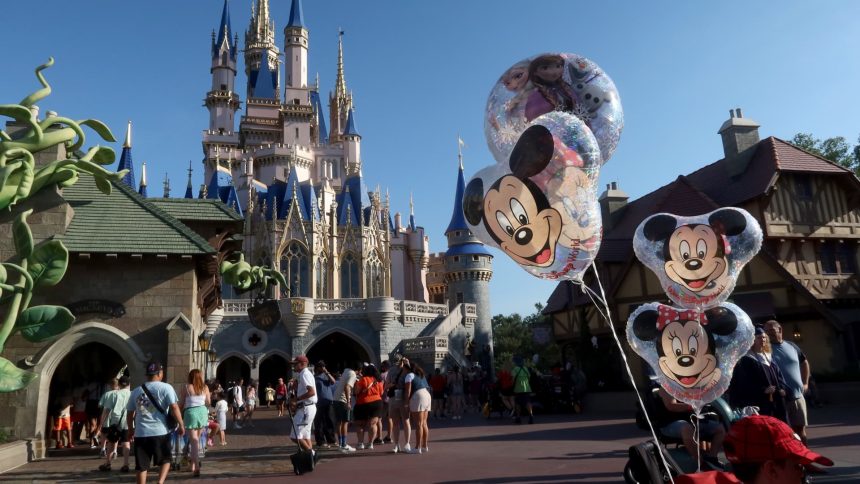People are increasingly skipping out on trips to Disney’s iconic theme parks, but that’s not holding back the company’s plans of enormous spending to expand the business. Disney offered encouraging updates earlier this month on what’s ahead at its parks and on its cruises as part of its 10-year, $60-billion investment in its experiences businesses. At a fan event in California, Disney started to fill in the details around the Club holding’s commitment to keeping its experiences fresh and exciting, such as a new section of Florida’s Magic Kingdom focused on villains and more ships in its cruise fleet. On the surface, the timing of the updates may seem a bit odd: Its parks business is weakening after a post-Covid pandemic boom made it the primary source of strength and profit growth while other parts of its business struggled. In fiscal 2022 and 2023 combined, Disney’s experiences unit, which houses the parks, generated 67.5% of the company’s operating income. But in the most recent quarter reported Aug. 7 , domestic parks in Florida and California showed softness as part of an overall trend of consumers getting more cautious as years of stubborn inflation take a toll. The company now expects flat attendance over the next few quarters — an outlook that added more pressure on the stock. Shares had already been down nearly 23% since Disney’s May earnings report when executives first mentioned a “normalization” of demand. We’re not joining the investors headed for the exits due to the theme park slowdown. Instead, we’re staying patient and actually view the stock as attractive at current levels, as Jim Cramer indicated on Thursday’s Morning Meeting . One reason why: Disney’s hefty investments to improve its parks and ships ensure they remain exciting for customers and a profit engine for the company later in the decade. As investors at the Club, not traders, we can afford to look at the bigger picture. A second reason: A comeback is underway at its entertainment unit, which encompasses its now-profitable streaming operations and theatrical movie releases. Among the announcements that Disney made earlier this month at its D23 super-fan event: Its “largest land expansion ever” with new attractions based on Disney’s iconic villains and the hit franchise “Cars” at Magic Kingdom in Orlando, Florida. The company also announced an additional four cruise ships that will be delivered between 2027 and 2031, boosting Disney’s fleet size to 13. “These are investments that should generate strong returns in the long run because experiences is its highest margin business and arguably most important to investors,” said Jeff Marks, the Club’s portfolio director. DIS YTD mountain Disney’s year-to-date stock performance. To be sure, we’re not oblivious to what Disney is facing in the short run. In Disney’s fiscal third quarter, its experiences segment – which includes theme parks, resorts, cruises, hotels, and consumer products – had operating income of $2.2 billion, a year-over-year drop of 3% that missed expectations of $2.3 billion. That represents a significant deceleration in growth from its first and second quarters, when operating income rose 8% and 12%, respectively. The even bigger problem for investors: Disney expects operating income for the business to decline by mid-single digits in the fourth quarter ending in September as consumers, particularly the lower-income cohort, continue to pull back on travel. Softer vacationer activity isn’t unique to Disney. When competitor Comcast reported its second quarter on July 23 , its theme parks revenue fell 10.6% year over year while a measure of profitability known as EBITDA — earnings, before interest, taxes, depreciation, and amortization — dropped 24% due to lower attendance at their domestic parks. Disney and Comcast , the parent company of CNBC, are fierce rivals in the Orlando area. Theme park attendance should improve over time as the economy normalizes and as Disney eventually starts launching new attractions. “[But] in the near-term you’re looking at higher capital spending for the parks business, which means lower free cash flow,” said Brandon Nispel, an analyst who covers Disney at KeyBanc Capital Markets. Nispel argued that negative sentiment around Disney’s theme parks performance could be a reason to have less conviction on the stock in the near term. “I am a firm believer that consensus expectations for next year remain far too high for Disney’s parks,” said Nispel, who has a hold rating on the stock. He anticipates attendance growth will turn negative for fiscal year 2025 and possibly even in 2026. “It’s not a one-or-two-quarter thing. We think it’s probably a six-to-eight-quarter thing for Disney in terms of domestic attendance.” Beyond the economy, Nispel said he believes another and arguably more significant reason for this protracted “lull period” is stiffer competition from Comcast Universal’s new Epic Universe theme park in Orlando, which is set to open next year with five themed worlds on 750 acres of land. “The argument can be made where a family now spends three days at Universal and two days at Disney,” he said. “I think that’s likely to result in Universal taking share in Orlando.” If this were to play out, Nispel said Disney would probably lose share to Universal until new attractions open in 2027, namely Tropical Americas as part of Animal Kingdom. Disney is wisely not sitting on its hands. “We wouldn’t be making capital investments in an accelerated way if we didn’t expect to accelerate growth out of those businesses,” CEO Bob Iger said on the August earnings call. “That’s true of the cruise ships, as well.” Goldman Sachs agrees with Iger’s contention and puts some estimates out that justify our Club belief as shareholders that it’s the right move long term. The analysts project a 4% to 5% drop in operating income over the next three quarters and a 2% drop in domestic park attendance in the same timeframe. But analysts still expect operating income for the experiences segment to deliver a compound annual growth rate (CAGR) in the high single digits between fiscal 2024 and 2030. Once the decade-long, $60 billion investment plan is completed, Disney could start adding $10 billion in annual profits per year, potentially doubling experiences operating income over the next decade, the analysts added. Goldman has a buy rating on Disney shares and a price target of $124 each, representing about more than 37% upside from current levels. Our Club price target is $130, with a buy-equivalent 1 rating . Silver screen success While we wait for the fruits of these investments, Disney’s entertainment business is busy finding its footing. That’s a key reason the long-term spending makes sense. “Disney has not ignited because it is very much viewed as being profligate,” Jim said Monday. “But the movie business came back for heaven’s sake, and that’s the bread and butter,” he said, referring to the idea that Disney’s films and the characters in them are the foundation for all Disney has to offer. The more excitement around its movies, the more interest in everything from theme parks to streaming services to branded merchandise. This dynamic is sometimes called Disney’s “flywheel.” After a string of box-office disappointments in recent years, the flywheel has been spinning fast in 2024. Disney already has big hits with “Inside Out 2,” “Deadpool & Wolverine” and “Alien: Romulus.” And there are more highly anticipated releases on the horizon, including “Mufasa: The Lion King” and “Moana 2.” In its fiscal third quarter, Disney delivered better-expected revenue and operating income for the unit that includes theatrical distribution, known as content sales and licensing. Operating income, in particular, rose more than $350 million year over year to $254 million. Executives expect “roughly similar” profitability in the upcoming fiscal fourth quarter, which is expected to be released in late November. In an interview, KeyBanc’s Nispel noted that Disney’s theatrical business is not making as much money as it was in the pre-pandemic days. Still, from an investor sentiment perspective, improvements in this business are notable. That’s especially true because the profitability of Disney’s combined streaming businesses — for years a huge drag on the bottom line and a frustration for investors — is on its way up. Together, Disney+ and Hulu from the entertainment division’s DTC line item and ESPN+ from the sports division were profitable in fiscal Q3, one quarter ahead of schedule. Granted, its operating income was only $47 million, but the trend is toward higher profits. Recently announced price hikes and a broader implementation of its password-sharing crackdown will help boost margins and profits. Another thing that will help, in a testament to the flywheel, is continued box office success. For example, since the first “Inside Out 2” trailer dropped in November 2023, more than a million people signed up for Disney+ to watch the original “Inside Out,” executives said. Nispel acknowledged the long-awaited turning tides for entertainment. “In the near term, there’s more momentum in the entertainment business, particularly around profit improvement in DTC, and then on the theatrical releases, which is offsetting the parks disappointment,” he said. (Jim Cramer’s Charitable Trust is long DIS. See here for a full list of the stocks.) As a subscriber to the CNBC Investing Club with Jim Cramer, you will receive a trade alert before Jim makes a trade. Jim waits 45 minutes after sending a trade alert before buying or selling a stock in his charitable trust’s portfolio. If Jim has talked about a stock on CNBC TV, he waits 72 hours after issuing the trade alert before executing the trade. THE ABOVE INVESTING CLUB INFORMATION IS SUBJECT TO OUR TERMS AND CONDITIONS AND PRIVACY POLICY , TOGETHER WITH OUR DISCLAIMER . NO FIDUCIARY OBLIGATION OR DUTY EXISTS, OR IS CREATED, BY VIRTUE OF YOUR RECEIPT OF ANY INFORMATION PROVIDED IN CONNECTION WITH THE INVESTING CLUB. NO SPECIFIC OUTCOME OR PROFIT IS GUARANTEED.
People are increasingly skipping out on trips to Disney’s iconic theme parks, but that’s not holding back the company’s plans of enormous spending to expand the business.
Read the full article here
News Room




